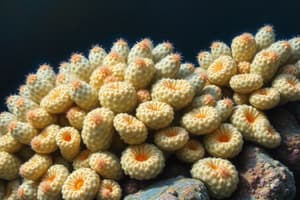Podcast
Questions and Answers
What is the primary function of the water transport system in sponges?
What is the primary function of the water transport system in sponges?
- Respiratory exchange
- Supporting the body structure
- Food gathering and removal of waste (correct)
- Protecting the body from predators
What is the characteristic of the body structure of sponges?
What is the characteristic of the body structure of sponges?
- Radial symmetry
- Bilateral symmetry
- Segmented body
- Asymmetrical (correct)
What is the function of choanocytes or collar cells in sponges?
What is the function of choanocytes or collar cells in sponges?
- To produce gametes
- To provide structural support
- To aid in digestion
- To line the spongocoel and canals (correct)
How do sponges reproduce asexually?
How do sponges reproduce asexually?
What is the unique feature of the skeleton of sponges?
What is the unique feature of the skeleton of sponges?
What is the characteristic of the fertilization process in sponges?
What is the characteristic of the fertilization process in sponges?
What is the main purpose of the minute pores (ostia) in the body wall of sponges?
What is the main purpose of the minute pores (ostia) in the body wall of sponges?
What is the term for the central cavity in sponges where water enters and exits?
What is the term for the central cavity in sponges where water enters and exits?
What is the function of the collar cells or choanocytes in sponges?
What is the function of the collar cells or choanocytes in sponges?
What is the characteristic of the skeletal system of sponges?
What is the characteristic of the skeletal system of sponges?
What is the type of symmetry exhibited by Echinodermata?
What is the type of symmetry exhibited by Echinodermata?
What is the characteristic of the development process in sponges?
What is the characteristic of the development process in sponges?
What is the type of reproduction exhibited by sponges?
What is the type of reproduction exhibited by sponges?
Flashcards are hidden until you start studying
Study Notes
Porifera: Characteristics and Features
- Members of this phylum are commonly known as sponges.
- They are generally marine and mostly asymmetrical animals.
- They are primitive multicellular animals with a cellular level of organisation.
- They have a water transport or canal system that brings in water through minute pores (ostia) in the body wall into a central cavity, spongocoel.
- Water then exits through the osculum, facilitating food gathering, respiratory exchange, and removal of waste.
- The spongocoel and canals are lined with choanocytes or collar cells.
- Digestion in sponges occurs at the intracellular level.
Body Structure and Support
- The body of a sponge is supported by a skeleton made up of spicules or spongin fibres.
Reproduction and Development
- Sponges are hermaphrodites, producing both eggs and sperms in the same individual.
- They reproduce asexually by fragmentation and sexually by formation of gametes.
- Fertilisation is internal and development is indirect, involving a larval stage that is morphologically distinct from the adult.
Examples of Sponges
- Sycon (Scypha)
- Spongilla (Fresh water sponge)
- Euspongia (Bath sponge)
Porifera: Characteristics and Features
- Members of this phylum are commonly known as sponges.
- They are generally marine and mostly asymmetrical animals.
- They are primitive multicellular animals with a cellular level of organisation.
- They have a water transport or canal system that brings in water through minute pores (ostia) in the body wall into a central cavity, spongocoel.
- Water then exits through the osculum, facilitating food gathering, respiratory exchange, and removal of waste.
- The spongocoel and canals are lined with choanocytes or collar cells.
- Digestion in sponges occurs at the intracellular level.
Body Structure and Support
- The body of a sponge is supported by a skeleton made up of spicules or spongin fibres.
Reproduction and Development
- Sponges are hermaphrodites, producing both eggs and sperms in the same individual.
- They reproduce asexually by fragmentation and sexually by formation of gametes.
- Fertilisation is internal and development is indirect, involving a larval stage that is morphologically distinct from the adult.
Examples of Sponges
- Sycon (Scypha)
- Spongilla (Fresh water sponge)
- Euspongia (Bath sponge)
Studying That Suits You
Use AI to generate personalized quizzes and flashcards to suit your learning preferences.



